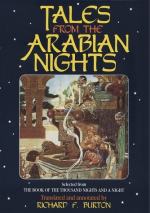[FN#239] The old name of the parish bull in rural England.
[FN#240] Arab. “Kawik:” see The Nights, vol. vi. 182, where the bird is called “Ak’ak.” Our dicts. do not give the word, but there is a “Kauk” (Kaka, yakuku) to cluck, and “Kauk” = an aquatic bird with a long neck. I assume “Kawik” to be an intensive form of the same root. The “Mother of Solomon” is a fanciful “Kunyah,” or bye name given to the bird by the Bhang-eater, suggesting his high opinion of her wisdom.
[FN#241] Arab. “Natur,” prop. a watchman: also a land-mark, a bench-mark of tamped clay.
[FN#242] In text “Bartaman” for “Martaban” = a pot, jar, or barrel-shaped vessel: others apply the term to fine porcelain which poison cannot affect. See Col. Yule’s Glossary, s. v. Martaban, where the quotation from Ibn Batutah shows that the term was current in the xivth century. Linschoten (i. 101) writes, “In this town (Martaban of Pegu) many of the great earthen pots are made, which in India are called Martananas, and many of them are carried throughout all India of all sorts both small and great: and some are so great that they will fill two pipes of water.” Pyrard (i. 259) applies the name to “certain handsome jars, of finer shape and larger than I have seen elsewhere” (Transl. by Albert Gray for the Hakluyt Soc. 1887). Mr. Hill adds that at Male the larger barrel-shaped jars of earthenware are still called “Mataban,” and Mr. P. Brown (Zillah Dictionary, 1852) finds the word preserved upon the Madras coast = a black jar in which rice is imported from Pegu.
[FN#243] The Arabic here changes person, “he repeated” after Eastern Fashion, and confuses the tale to European readers.
[FN#244] Such treasure trove belonging to the State, i.e. the King.
[FN#245] Arab. “Huri” for “Hir” = a pool, marsh, or quagmire, in fact corresponding with our vulgar “bogshop.” Dr. Steingass would read “Hauri,” a “mansub” of “Haur” = pond, quagmire, which, in connection with a Hammam, may = sink, sewer, etc.
[FN#246] The Bedlam: see vol. i. 288.
[FN#247] Arab. “Tamtar aysh?” (i.e. Ayyu shayyin, see vol. i. 79). I may note that the vulgar abbreviation is of ancient date. Also the Egyptian dialect has borrowed, from its ancestor the Coptic, the practice of putting the interrogatory pronoun or adverb after (not before the verb, e.g. “Ra’ih fayn?” = Wending (art thou) whither? It is regretable that Egyptian scholars do not see the absolute necessity of studying Coptic, and this default is the sole imperfection of the late Dr. Spitta Bey’s admirable Grammar of Egyptian.




